A clear road map for 405 emergencies
June 22, 2011
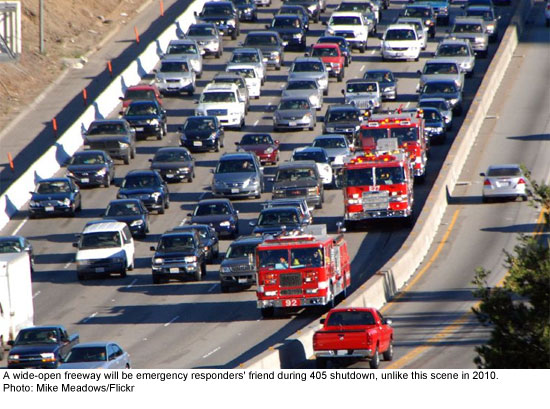
Paramedics on motorcycles. A world-class art facility repurposed as a firefighting staging area. And a 10-mile expanse of the 405 Freeway stretching out, car-free, as an enormous potential helicopter landing pad.
Talk about turning the problem into the solution.
Sure, the 405 Freeway will be closed to all of us for 53 straight hours in mid-July. But for an army of law enforcement and public safety professionals, the freeway has emerged as a key element in a wide-ranging emergency response plan being put into place to cope with whatever may arise during the closure.
Not only will the 405 provide a possible helicopter landing strip, it also stands as a quick response conduit for police and firefighters, and even, in the event of a fire or natural disaster, a mass evacuation route.
“The freeway’s available to us if we need it at any time,” said LAPD spokesman Lt. Andy Neiman. Most of the 405 closure zone—stretching north from the 10 to the 101, and south from the 101 to Getty Center Drive—will be readily accessible to emergency responders during the freeway shutdown. The section immediately under the Mulholland Bridge—where the south side is being demolished, prompting the freeway closure in the first place—could even be made available if needed, although it would likely take several hours of clean-up to reopen a lane under the bridge once demo work had started in earnest, Neiman said.
Community concerns about gridlock on local streets—and about emergency vehicles being able to respond to calls promptly—have been running high as the 53-hour closure approaches. But public safety planners say they’re confident they’ll be able to get through.
“If anything happens in those areas, I would almost expect that people will have a quicker response than normal,” said Los Angeles Fire Department Captain Alicia Mathis. “We want the community to be completely comfortable with our ability to respond.”
Beyond the freeway itself, the Getty Center has offered to make itself available as a staging area for firefighting resources during the closure. Mathis said the facility was built with firefighting capabilities in mind, including an augmented water supply, roadways constructed to accommodate heavy fire trucks, a helicopter landing area and a design that would allow it to be temporarily converted to a command post in the event of a major brushfire or other disaster. “In addition to being an art asset and a beautiful facility, it’s actually very functional,” she said.
In addition to the Getty and the freeway, the department has identified a number of other “helispots” where choppers will be able to land and take off if necessary during the closure. Brush patrol rigs will be continuously moving through the area—including one each for Encino, the Getty Center and the Bel Air Crest and Mountaingate neighborhoods—and an infusion of extra firefighters and other equipment is planned along with full staffing at the existing fire stations in the area, she said.
The fire department also will be fielding teams of paramedics on motorcycles.
While the fire department has deployed paramedic bicycle teams at LAX and during large festivals, “the motorcycle team is really something new to make sure we have quick access” during the freeway closure, Mathis said. The two-wheel paramedics won’t be able to transport patients, but will have a full array of equipment, such as defibrillators, for initial treatment of a medical emergency.
Likewise, LAPD motor officers will be on the frontlines during the freeway shutdown. “For any hot shot or important call, they will be the first responders,” Lt. Neiman said.
To make sure that emergency responders are in position, the closure area is being subdivided into four “branches” located on either side of the 405 and above and below the Mulholland Bridge, Neiman said.
The public safety and traffic response to the closure is being planned and managed by a “unified command” consisting of the LAPD, the Los Angeles Fire Department, the CHP and the Los Angeles Department of Transportation. A centralized command post will be up and running at the city’s Emergency Operations Center during the weekend.
LAPD Cmdr. James Cansler said all the agencies would have high staffing levels during the shutdown, including a “heavy deployment of traffic officers and engineers” to adjust street signals and open up intersections depending on the flow of traffic. Cansler added that police and fire helicopters would be keeping tabs on the situation from above.
Metro spokesman Marc Littman said it was “premature to speculate” about what the cost of the public safety and traffic deployment would be during the 405 shutdown. “No doubt the tab will be hefty but ensuring public safety is paramount, and we’re not going to skimp on safety,” he said in an e-mail.
The freeway closure is necessary to protect the public during demolition because the Mulholland Bridge is so steep, Metro officials say. Some ramp and lane closures will begin the evening of Friday, July 15. The entire freeway will be closed all of Saturday, July 16, and Sunday, July 17, and is set to reopen at 5 a.m. on Monday, July 18. (The entire exercise will be repeated some 11 months later, when the north side of the bridge is demolished.)
The $1.034 billion project will add a 10-mile northbound carpool lane to the 405 Freeway and modernize three bridges over it, in addition to widening underpasses and creating improvements such as new “flyover” ramps at Wilshire Boulevard.
A community meeting is scheduled for Thursday, June 23, at the Skirball Center for those interested in learning more about plans for the closure. In addition, an online chat will be held on Wednesday, June 29.
Even with all of the advance planning, though, the best plan will be to steer clear of the area altogether. CHP Lt. Mark Garrett said there was just one word for what the average motorist would be experiencing that weekend: “Frustration. That’s all you can say.”

Posted 6/22/11
405 community meeting tonight
June 20, 2011
If you’ve got questions or concerns about the mid-July closure of the 405 Freeway, here’s your chance to get some answers.
A community meeting will take place tonight—June 23, 2011—at the Skirball Center’s Ahmanson Hall, located at 2701 N. Sepulveda Boulevard, Los Angeles, 90049. The meeting runs from 6 p.m.-8 p.m. Representatives from all the agencies involved—Metro, Caltrans, Los Angeles Department of Transportation, Los Angeles Police Department, Los Angeles Fire Department and the California Highway Patrol—are scheduled to attend.
For more information, please call the project’s hotline, (213) 922-3665 or email [email protected]
Posted 6/23/11
Invite a farmer to a 405 sleepover
June 15, 2011
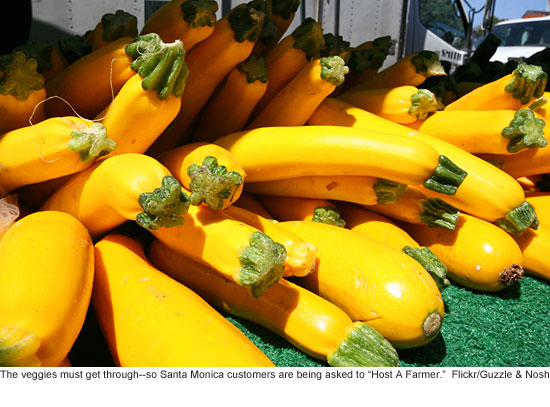 You can close the freeway, but please—don’t mess with our fresh-grown farmers market fare.
You can close the freeway, but please—don’t mess with our fresh-grown farmers market fare.
The Santa Monica Farmers Market, bracing for the mid-July closure of the 405 Freeway, has come up with a “Host A Farmer” program to ensure that growers can deliver the goods for the city’s markets scheduled for Saturday, July 16, and Sunday, July 17, despite the 53-hour shutdown.
With the midsummer bounty of corn, tomatoes, peaches and figs coming into season, a presumably gridlocked metropolis will be counting on local farmers markets for entertainment as well as sustenance during the weekend.
Customers and fresh food enthusiasts can do their part by offering to put up a farmer for the weekend, allowing growers to get into town ahead of the shutdown, which begins with ramp and lane closures on the evening of Friday, July 15. (The freeway will be completely closed in both directions all of Saturday and Sunday, with a scheduled reopening of 5 a.m. on Monday, July 18. The northbound 405 will be closed from the 10 Freeway to the 101. The southbound 405 will be closed from the 101 to Getty Center Drive. This printer-friendly brochure has all the closure details.)
This flyer—to be distributed starting Wednesday at the Santa Monica Farmers Market at Arizona Avenue and 2nd Street—suggests that market customers approach growers directly if they’d like to offer a place to stay.
Arrangements also are underway to allow farmers to park their trucks all weekend in Santa Monica city lots. Other nearby markets—including those in Beverly Hills, Encino, Hollywood and Sherman Oaks—say they’re planning to be open for business and, at least so far, are counting on their farmer-vendors to be able to get through on surface streets and freeways, such as the 5, 101 and the stretch of the 405 south of the 10 that will remain open.
Posted 6/21/11
‘Carmageddon’ or BBQ—it’s up to us
June 8, 2011
Forget nothing to fear but fear itself. As they launched an urgent campaign to keep people away from the 405 Freeway in mid-July, L.A.’s leaders said there’s good reason to be afraid—very afraid—of what a 53-hour closure will bring.
With the shutdown of one of the world’s busiest freeways looming, government officials didn’t try to gloss over what driving in the area—and around the region—would be like on the weekend of July 15-18.
“It will be an absolute nightmare,” said Los Angeles Mayor Antonio Villaraigosa.
“Avoid the area like the plague…Stay the hell away from the 405 in the middle of July,” said L.A. City Councilman Paul Koretz.
“Since this is Los Angeles, we think this project should probably be renamed ‘The Nightmare on the 405,’ ” said Richard Katz, chair of the Metrolink board.
“It’s going to be a really horrendous weekend,” Michael Miles, district director of Caltrans District 7. “It’s going to back up probably all the way to San Bernardino County…It’s just going to make a mess…You need to stay away.”
“They’re calling this Carmageddon,” said Supervisor Zev Yaroslavsky. “And our objective is to prove all of the predictors wrong, that it doesn’t need to be a Carmageddon.”
When it was his turn to speak, L.A. City Councilman Bill Rosendahl threw in the rhetorical towel. “They used all the words, there’s nothing more left to say…I’ve got no hyperbole other than, folks, just grab your calendar and put an X on 15, 16 and 17 and don’t come to this side of town to get over the hill one way or the other.”
Amid all the dire prognostications, there were a few bits of good news to come out of Monday’s news conference, the first salvo in a publicity blitz to ensure the motoring public is well aware that the 405 will be closing for 53 straight hours for demolition of the Mulholland Bridge. (Some ramps will begin closing at 7 p.m. on Friday, July 15. The entire freeway will be closed on Saturday, July 16, and Sunday, July 17, and will reopen at 5 a.m. on Monday, July 18. The project will add a northbound carpool lane from the 10 to the 101, along with other improvements.)
The weekend won’t be a lost cause for mobility in the region—if travelers rely on public transportation. It was announced that they’ll be able to ride free on Metro subway lines that weekend. And service will be expanded on Metro bus lines and on the Metrolink train system. Airport officials announced that they are contacting hotels around LAX to see if they will offer deals to passengers who want to avoid freeway hassles by getting to the airport the night before their flight.
Even the humble backyard cookout was singled out—more than once—by its fans in high places.
“A BBQ would be good that weekend,” Miles said. Villaraigosa concurred, making the suggestion both in English and Spanish.
And soon—assuming everyone heeds the advice to “stay the heck out of here”—the July freeway closure will be history, Yaroslavsky said. (Although it will all be repeated when the other side of the bridge comes down some 11 months later.)
“It’s going to be over before we know it,” Yaroslavsky said. “So Los Angeles, we need to suck it up.”
Posted 6/6/11
A closure heard ’round the world
June 6, 2011
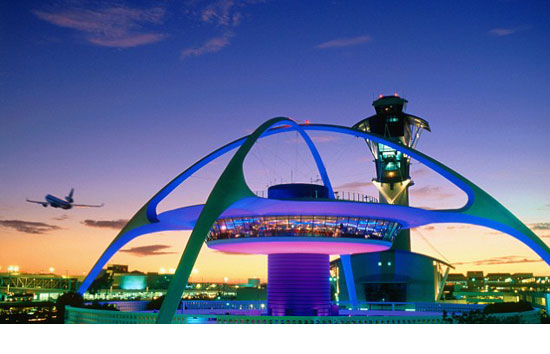 In most big cities, a detour is just a detour. Not in a world capital like Los Angeles.
In most big cities, a detour is just a detour. Not in a world capital like Los Angeles.
When a 10-mile stretch of one of the nation’s busiest freeways shuts down next month for a full weekend at the height of the summer tourist season, it won’t be enough for the locals to know that the 405 Freeway will be temporarily closed just north of Los Angeles International Airport. Travelers from around the globe will also have to be made aware that the freeway will be cerrará. And fermée. And geschlossen, 被 闭, and 폐쇄.
To that end, officials from LAX, Metro, Caltrans and other local organizations have created one of the world’s biggest phone trees to spread the word about the 53-hour closure that will start before midnight on Friday, July 15, and continue through the pre-dawn hours of Monday, July 18. The shut down through the Sepulveda Pass has been ordered as a safety precaution during demolition of the Mulholland Bridge, part of a massive freeway-widening project. (Full details are here.)
Notices of the closure are going out in eight languages via TV, print, radio, web and social media, and are expected to be further translated as they ricochet around the planet. A separate flyer is being prepared for airlines to forward to individual ticket holders.
The Los Angeles Convention and Visitors Bureau is alerting some 180,000 travel professionals, ticket brokers, hotels, restaurants, travel writers and individual tourists about the shut down via targeted newsletters, says spokesman Michael McDowell. Another 600,000 or so of the bureau’s Facebook friends and Twitter followers will also get the memo.
And for those who still manage to land here without knowing about the closure, LAX is preparing to call in extra troops of volunteer passenger information assistants to beef up the 13 information booths at the airport.
“Our goal is to ensure that passengers coming in and out plan ahead,” says Nancy Castles, public relations director for LAX, which is expected to see more than 170,500 travelers per day during that weekend, including some 52,500 international tourists.
About 40% of these travelers will connect to other flights. And many of those remaining in the region will likely rely on cabbies, shuttle operators, local friends or relatives who by then will hopefully know to use detours, says Castles. But for others, she adds, delays and unfamiliarity with L.A. will be a serious source of frustration.
“If we take the traffic analysts at their word, the 405 will have gridlock for 28 miles north of the 101 and 24 miles south of the 10 if they don’t get 70% of the cars off the freeway that would normally drive it on a summer weekend,” she says. “And if everyone is trying to go east or west on the Santa Monica Freeway, that’s going to back up beyond downtown L.A.”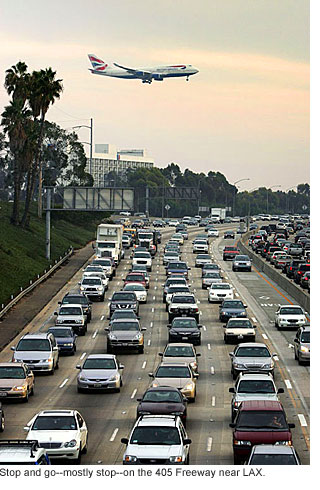
Heading that off is a big job, Castles concedes, but not nearly as big as it was during the 1984 Olympics, when logistical bulletins had to be gotten out without the benefit of text messaging, social media and the Internet.
“Time is on our side and, this time, technology is on our side,” Castles says.
Julie Valentine, director of corporate services in the Los Angeles office of the travel agency Altour, says the firm is aware that “traffic is going to be hellish.” But Altour’s booking system, she says, allows the agency to notify clients directly and offer alternative booking times if their travel dates are flexible.
The Los Angeles visitors bureau, meanwhile, already has issued advisories to its offices in the U.K., Germany, Japan, Korea, Australia, China and Miami, which serves the Americas. The organization also has a special link on its website to the 405 closure.
Looking on the bright side, bureau spokesman McDowell says the closure actually is well-timed because “happily there are no major conventions on those days and we’re not aware of any significantly large tour groups. But we are getting the word out to the tour operators to avoid the 405.”
His group is recommending tour destinations during the closure that can be reached through Metro’s transit system, such as Downtown L.A., Hollywood and Universal Studios. The visitor’s bureau also is working with hotels throughout the region, particularly those popular with international travelers, including the Luxe Hotel Sunset Boulevard and the Hotel Angeleno, both of which are within the affected area of the 405.
Reginald Archambault, general manager at the Luxe, says reservation clerks are advising guests of the closure in advance. But so far, he says, those fair warnings haven’t put a dent in bookings. “This is just one segment of a long project,” he says, “so I don’t think people are completely surprised.”
L.A.’s first line of tourism ambassadors—airport cabbies and limo drivers—seem less sanguine about how all this will unfold. Will Hebler, senior director of sales and marketing for Yellow Cab of Los Angeles, says that while fares out of LAX shouldn’t be as impacted as those in the areas around Brentwood and Mulholland, “it’s going to affect dispatchers because they’re going to have to find ways from Point A to Point C.”
Elton Silva, owner-operator of a small limo company based in Willowbrook, says that although much of his business is airport-based, he hopes to avoid the 405 altogether that weekend.
“It’s not going to be worth it,” he says. “We do a lot of fixed-rate business, and this means we’ll have to spend a bunch of hours and waste a lot of time and gas sitting in traffic. And it’s going to be hard to find a shortcut because everybody will be looking for the same thing.”
Officials at SuperShuttle, meanwhile, say they’re meeting this week to map alternative routes to popular destinations. (As a side note, they’re reassuring travelers that the more circuitous routes will not mean higher SuperShuttle fares.)
Of course, one option would be for travelers to choose airports other than LAX. Castles says local tourism officials won’t be suggesting that. But they are asking everyone to be prepared.
“We want people to know they need to allot plenty of time once they get here,” says Castles. “Don’t plan to land at 1 p.m. on a Sunday and be on your cruise ship by three, even if that’s what you’re used to. If you’re coming in domestically and thinking, ‘Well, I only need 90 minutes or whatever to get to that wedding’, allow more time than you normally would. Don’t cut it close.”
Posted 6/2/11
Where L.A.’s lost weekend hits home
June 2, 2011
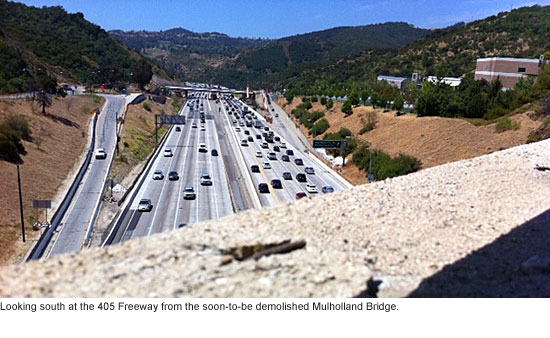 In neighborhoods all around the 405 Freeway, people are scrambling to find answers to the biggest question of the summer: To get out of town, or to hunker down?
In neighborhoods all around the 405 Freeway, people are scrambling to find answers to the biggest question of the summer: To get out of town, or to hunker down?
“I’m terrified. I have company coming from out of town. What are we going to do?” said Dr. Anne Kelly as she waited to have her hair done at a local salon this week.
“We’re going to be virtually prisoners,” said Kelly, a psychologist who’s lived in the Roscomare Valley neighborhood on the east side of the freeway for 40 years. “I understand that things have to be done, but boy oh boy.”
When it was suggested that her professional services may be in demand, she joked: “I think you’re going to need a psychiatrist to dispense medication to deal with all the road rage.”
Yes, when you close one of the world’s busiest freeways for 53 straight hours, emotions run high—and people run scared. That goes double for folks in neighborhoods near the Mulholland Bridge, which is being demolished and rebuilt to make way for a 10-mile northbound carpool lane on the 405.
After a couple of hours of prep work that starts before midnight on Friday, July 15, the entire freeway will be closed all day Saturday, July 16, and Sunday, July 17, reopening at 5 a.m. Monday, July 18. The closure will stretch north from the 10 Freeway all the way to the 101, and south from the 101 to Getty Center Drive. Even with the official mantra of “Plan Ahead, Avoid The Area, Or Stay Home,” there are concerns in the community that huge numbers of motorists will have to be diverted onto their streets, causing gridlock and placing locals under virtual house arrest.
Already, a spirit of resignation is taking hold in Roscomare Valley, on the west side of Bel-Air, as some neighbors get ready to take cocooning to a whole new level.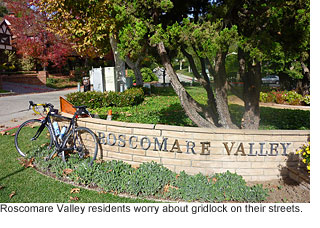
“As a joke, I said let’s get enough food in for the weekend and not go out. I think it’ll be awful getting out of town,” said Belinda Broughton, a violinist having lunch with her son, Oliver Britten, at the tiny Sugar Cube café.
The same goes for Paul Gamberg, who represents the Roscomare Valley as an alternate on the freeway project’s community advisory committee.
“We’re planning to be landlocked and to swim a lot. We’ll provision up. I don’t think we’ll have a hard time getting to Whole Foods, but we might,” said Gamberg, who oversees a Yahoo message group that serves as a sounding board among neighbors concerned about the project.
“I get emails all the time from people who are up in arms,” he said. “There’s been a lot of fury.”
A lot of it is apprehension about the “hellish” 53-hour freeway closure. But what really has him on edge is what happens afterward—when routes through the “desirable, paradisiacal neighborhood” become clogged and increased traffic worsens the condition of local roadways.
“We’re the first canyon east of the 405,” he said. “The reason our road is closed to through traffic is because it’s a narrow street and the city can ill afford to keep up with the potholes as it is.”
While some are getting ready to tough it out at home, others are making plans to hit the road.
“We’re getting out of here! We’re going to go camping,” said Joko Tamura, who’s also had to reschedule her son’s 11th birthday party from July 16—the actual date—to July 9. (And Tamura’s not the only one to take a red pencil to the calendar; weddings, religious services and museum exhibitions in the area also have been shuttered, moved or postponed.)
Amid all the apprehension, there are those in the neighborhood who feel that the 53-hour closure will just be one more chapter in the long and difficult saga of the $1.034 billion I-405 Sepulveda Pass widening project.
“The street is just awful. Getting to the 405 used to be 5 minutes; now it’s much longer. And Sunset is just unbearable,” said Karen Klaustermeyer, who moved to the Roscomare area in 1971. “It’s just tearing up everything. The city of L.A. should look at the deterioration…I think they’ve forgotten about us.”
For those closest to the action, the best survival strategy for getting through the weekend-long freeway closure will be acceptance—and a positive attitude, said Robert Ringler, president of the Bel-Air Beverly Crest Neighborhood Council and a chair of the LAPD’s West Bureau Traffic Committee. “Screaming and yelling is fruitless,” he said. “Attitude—it’s so important. Attitude and planning.”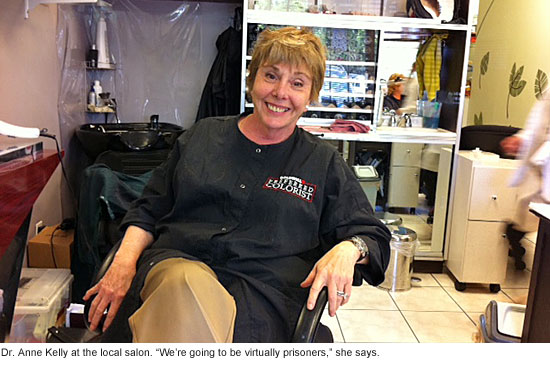
Posted 6/2/11
Rx for a 405 headache
June 2, 2011
 Allow me to be blunt: it’s going to be a mess out there.
Allow me to be blunt: it’s going to be a mess out there.
As you may have heard, the 405 Freeway is being shut down through the Sepulveda Pass for 53 hours next month to accommodate demolition of the Mulholland Bridge, part of a massive freeway-widening project. The closure—an essential safety precaution—will begin before midnight on Friday, July 15th, and continue into the pre-dawn hours of Monday, July 18th.
Each weekend, roughly 500,000 vehicles move through this stretch of freeway, where detours are difficult to map and navigate because of the area’s mountainous geography. Beyond the obvious traffic implications, life for residents and businesses in the 10-mile impact zone will be challenging, at best. As the county supervisor for this district, my office has been working closely with the project team, and I assure you that we’re committed to doing everything we can to anticipate and ease the pain for all.
But the truth is that we must work together by planning now.
Obviously, the best way to steer clear of the aggravation zone and reduce congestion is to stay home that weekend or make plans in the neighborhood, like catching a movie at the local theater. If you’re supposed to work, try to change your schedule, take a couple vacation days or telecommute.
If you must hit the road, chart a course using the region’s many other freeways. You may end up driving more miles, but I guarantee you’ll get to your destination faster than by gambling on 405 detours that could leave you stuck for hours.
For those of you who think you can outsmart this potential mother of all traffic jams, my advice is simple: save your gas. After representing the San Fernando Valley and Westside for more than three decades as a Los Angeles city councilman and county supervisor, I know virtually every shortcut in those parts—and none will work because of the sheer volume of vehicles being taken off the freeway.
In the days and weeks ahead, you’ll be hearing lots more about the 405 closure from the folks at Metro, who are not only spearheading the construction project but launching a massive public outreach campaign. We don’t want anyone surprised by the enormity of the undertaking and its inevitable fallout. (For Metro’s latest information on the I-405 Sepulveda Pass widening project, click here.)
It’s been my experience that, armed with the facts, Angelenos can be very enterprising, especially when it comes to their roads. Just think back to 1994, after the Northridge Earthquake, when a portion of the Santa Monica Freeway collapsed and was closed for nearly three months. Yes, there was plenty of frustration but motorists adapted and coped. While this upcoming closure will be a pain, it’s only for a weekend. So if you roll with the realities, you’ll avoid a trunk load of aggravation.
For more, listen here to my KPCC interview with Larry Mantle on AirTalk. Also, visit the special “405 Report” section of my website and follow my freeway updates on Twitter and Facebook.
Posted 6/2/11
Behind the scales at “The Biggest Loser”
May 24, 2011
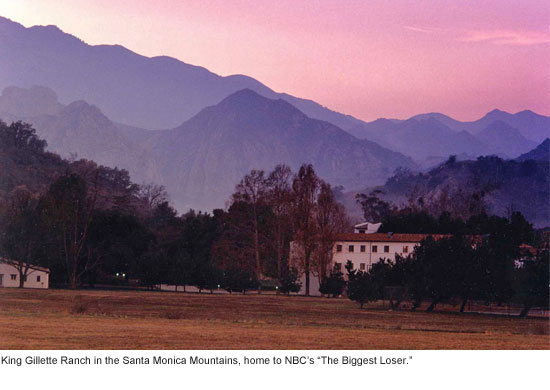 On the hit TV show “The Biggest Loser,” it’s known simply as “The Ranch”—a serene, sprawling property where thousands of pounds and decades of shame have been shed during the past four years.
On the hit TV show “The Biggest Loser,” it’s known simply as “The Ranch”—a serene, sprawling property where thousands of pounds and decades of shame have been shed during the past four years.
For months at a time, the mountainous acreage is home to dozens of contestants who battle their demons and their weight to gain the title of “The Biggest Loser,” along with a tidy purse of $250,000. But the property, complete with its Hollywood-imported state-of-the-art gym, is no ordinary production set.
Unbeknownst to the NBC show’s millions of fans, who’ll be tuning in for tonight’s finale, “The Ranch” is one of Los Angeles’ most historic and dazzling properties, designed by famed architect Wallace Neff in the late 1920s for razor-blade tycoon King Gillette. In 2005, an unprecedented coalition of government agencies, including Los Angeles County, raised $34 million to protect the ranch’s 600 oak-studded acres from expansive development.
Located along Mulholland Highway in Calabasas, King Gillette Ranch is being transformed into a gateway destination for the Santa Monica Mountains recreation area. A new visitor’s center currently is under construction there. The property is operated by the Mountains Recreation and Conservation Authority, which receives $50,000 a month from the show to help underwrite the agency’s operations throughout the region.
Managing the property for the MRCA is ranger Scott Hughes, a fit and trim Army veteran who has the tricky job of ensuring that the public has unfettered access to the property—including dozens of grade-school campers—while helping the show’s producers create an illusion of exclusivity and privacy. Talk about your mixed-use property.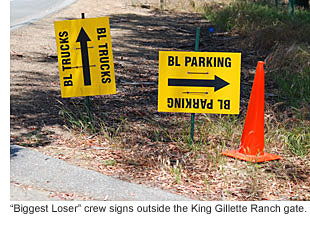
“There’s no effective job description for this position,” Hughes says. “I add something new to it every day.” One thing, however, remains a constant above all else, he says. “It’s my job to protect this property.”
Living on the grounds with his wife and a 15-year-old son, Hughes has gotten to know not only the production crew but each of “The Biggest Loser” contestants, some of whom arrive weighing nearly 500 pounds and carrying a heavy psychological burden that has been with many of them since childhood.
“Season after season, you see them around the property,” Hughes says. “You can see the sadness in their eyes.” But then, after weeks of healthy dieting and high-intensity workouts, “you can literally see their spirits lift. It’s an amazing transition.”
There’s also been a fair share of drama on the ranch, including romances and, this season, the abrupt departure of one of the contest’s frontrunners—former Olympic wrestler Rulon Gardner, who won a gold medal in the 2000 Sydney Summer Games by beating the seemingly invincible Russian Alexander Karelin.
Gardner, 39, came to the ranch weighing 474 pounds, 200 more than during his storied wrestling career. In late April, after having lost 188 pounds, he announced during the show that he was going home “for personal reasons”—the first contestant to voluntarily walk away from the ranch, leaving behind mystery and speculation about his hasty exit.
“The Biggest Loser’s” relationship with the ranch began shortly after it was acquired as public land from the previous owner, Soka University, which had been blocked in its plan to expand the campus to accommodate some 5,000 students. The show’s crew had come to film a single competition, or “challenge,” between the contestants in season four.
But the producers quickly recognized that the property’s beauty and its structures would represent a substantial upgrade. Back then, contestants were living in the state’s old mental institution in Camarillo. Now they’d be bunking in an annex to the Gillette mansion built in the late 1950s for an order of monks by one of the ranch’s several owners over the decades, who have included MGM director Clarence Brown and church leader Elizabeth Clare Prophet.
On a recent day at the ranch, the “Biggest Loser” crew was busy preparing the place for the upcoming season, which starts production in early June. The kitchen, with its to-die-for appliances, is being redone, as are the “living room” and the bedrooms. Ranger Hughes was making sure that a dead oak limb was carefully cut by his staff so that it would not collapse on an outdoor table where interviews with contestants are sometimes filmed.
Despite all the activity, Hughes says, “this is the calm before the storm. The storm is when there’s 80 to 100 people here.”
Posted 5/24/11
405 reasons to plan a new July route [updated]
May 18, 2011
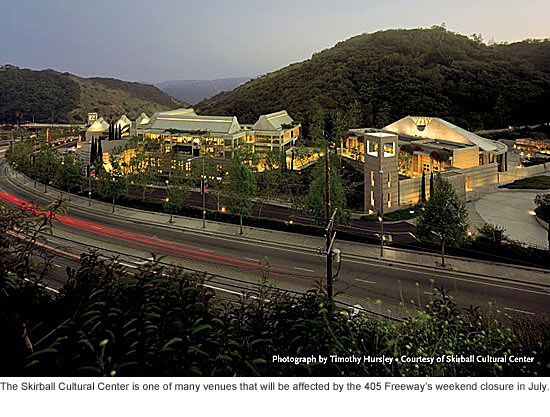 On July 15, moviegoers around the country will find out whether Voldemort meets his doom in a showdown with the wizarding world. But if you’re thinking of catching a midnight showing of “Harry Potter and the Deathly Hallows: Part 2” in Westwood, better find a way to get there that doesn’t involve the 405 Freeway.
On July 15, moviegoers around the country will find out whether Voldemort meets his doom in a showdown with the wizarding world. But if you’re thinking of catching a midnight showing of “Harry Potter and the Deathly Hallows: Part 2” in Westwood, better find a way to get there that doesn’t involve the 405 Freeway.
That same night marks the beginning of the end for the Mulholland Bridge. After two hours of prep work starting at 10 p.m. on July 15, demolition of the bridge will begin just after midnight—a maneuver that will require a weekend-long closure of one of the most heavily traveled freeways in the nation.
Moviegoers are just one L.A. interest group that will need to come up with alternate routes to navigate the 53-hour closure, which will be in effect all day Saturday, July 16, and Sunday, July 17, and will continue till 5 a.m. on Monday, July 18. At this point, plans call for closing the freeway from Getty Center Drive to the 101 Freeway, but that and other details may change depending on the outcome of meetings being held this week among Metro, the CHP and other agencies.
Updated 5/27/11: The latest plans call for the 405 Freeway to be closed northbound from the 10 Freeway to the 101. The southbound freeway will be closed from the 101 to the Getty Center Drive offramps. Full details are here.
Already, the mega-closure has event organizers and others scrambling for ways to cope. From LAX-bound travelers to beachgoers, golf lovers to museum hoppers, the closure promises to throw a big curve into that perennial L.A. question of how to get there from here.
The Skirball Cultural Center has decided to close its gallery doors altogether for the weekend—which means you’ll need to pick another time to check out the center’s popular Houdini and “Masters of Illusion: Jewish Magicians of the Golden Age” exhibits.
At this point, just one private event—a wedding—is still on the books for the Skirball that weekend. The staff is “cooperating closely with the families to come up with best options for guiding guests to our site as efficiently as possible and extending welcome to them upon arrival and throughout the event,” spokeswoman Mia Cariño said in an email.
Like that intrepid wedding party, the nearby Getty Center has opted to stay the course and will remain open. The Getty expects “strong visitorship despite the freeway construction,” spokeswoman Julie Jaskol said in a statement, pointing out that, as plans stand now, the northbound Getty Center Drive ramp will be open, while visitors coming from the south will need to take Sepulveda Boulevard.
Updated 6/2/11: The Getty has since decided to close for the weekend. And that last wedding party at the Skirball? They’ve rescheduled for July15.
The Hermosa Beach Open Beach Volleyball Tournament is also scheduled for that weekend—and the freeway closure plans were not welcome news to organizer Dave Williams.
“This is the first I’m hearing of it. Yes, it will be very negative,” he said. “It’s a big event. We may have to move it.”
Further south, the Trump National Golf Course in Rancho Palos Verdes is the setting for the big Los Angeles Police Celebrity Annual Golf Tournament on Saturday, July 16—which may also require some extra planning by those traveling from the Westside or San Fernando Valley.
“We’re trying to figure out how we’re going to notify people of alternate routes,” said Alan Atkins, executive director of the Los Angeles Police Memorial Foundation, which puts on the traditionally star-studded tournament, to be hosted this year by Jerry West. “It’s going to cause a lot of headaches because probably half of them come from the Westside.”
And at UCLA, school’s not in session, but parents of students enrolled in high school summer programs on the campus that weekend are being notified of potential pick-up and drop-off challenges.
Whatever your summer plans may be, the advice from Metro, which along with Caltrans is running the 405 Sepulveda Pass Improvements Project, is to stay home that weekend if possible or become well-acquainted with the official detour maps before leaving home, since freeways and surface streets beyond the 405 may be affected.
Mike Barbour, in charge of the project for Metro, said picking the date for the weekend-long closure meant avoiding holiday weekends and times when schools were in session.
“We think this is the right date. It was sort of a light weekend, really,” Barbour said.
While the project’s other demolition work on the Sunset and Skirball bridges required a series of overnight closures of the freeway, the steepness of the Mulholland Bridge means that it will be safer for motorists if the demo work is done over one weekend, Metro officials said.
Still, the demolition of the Mulholland Bridge will be the easy part compared to the “very daunting” task of arranging and communicating the freeway closure, Barbour said.
“I would say that the technical work is not that big of a deal,” Barbour said. “But traffic management, and working with all these different agencies, and coming up with a plan to convince people to stay off the freeway—it’s very significant. It’s very challenging.”




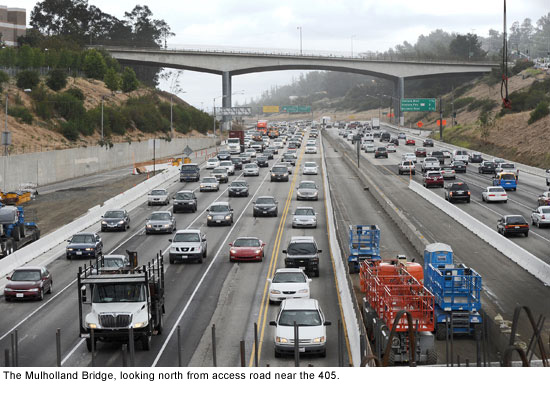
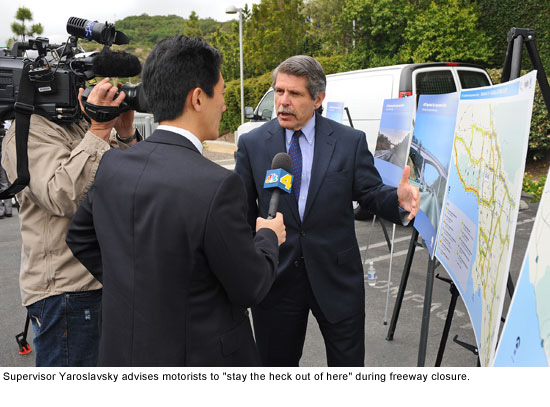
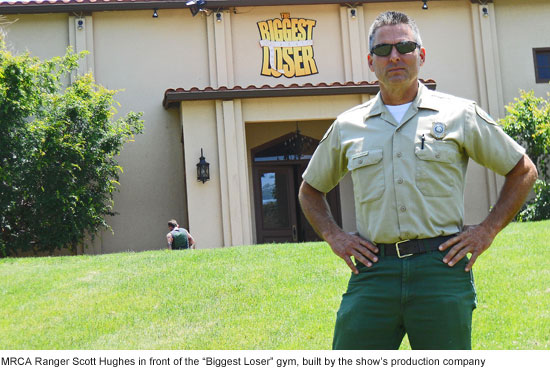
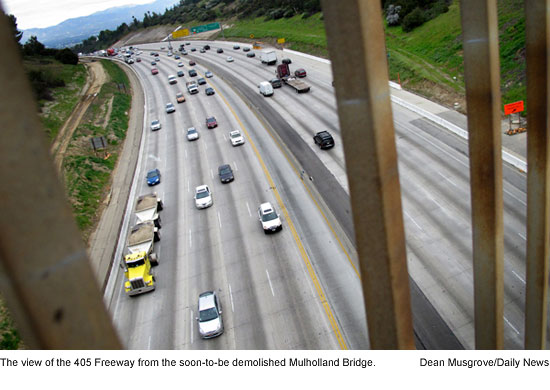







 405 bridge work causes a stink
405 bridge work causes a stink

